Peter Ablinger:
Quartz
from: "Augmented Studies"
2001-2015
a multi part installation
sand, quartz watch, electronics, video, paper, bed sheets, hour glas, other materials
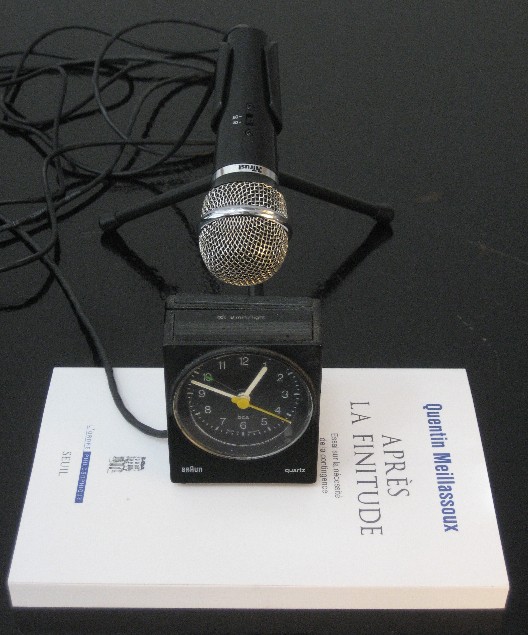
quartz watch, book and microphone, detail from "Quartz", studio draft
QUARZ
"Wieviele Sandkörner sind in 1 Kubikmeter? Und wieviel Raum ist 7 Milliarden Sandkörner? Eins davon bin ich." (Peter Ablinger)
Zwei kleine gerahmte Reisefotos von Peter Ablinger sind der Ausgangspunkt seiner 5-teiligen Ausstellung: auf beiden Bildern sind Sanddünen zu sehen, das eine zeigt die dänische Wanderdüne Råbjerg Mile 2010, das andere die iranische Sandwüste bei Mesr 2011. Beide Bilder, kombiniert mit einer Sanduhr, eröffnen die Ausstellung wie eine programmatische Überschrift welche den Sand verschiedener Orte mit dem Vergehen der Zeit, dem klassischen "Vanitas"-Motiv verknüpft.
Quarz ist das Mineral aus dem der Sand zum allergrössten Teil besteht. Im nächsten Raum begegnen wir einer Quarzuhr deren Ticken mit einem Mikrophon verstärkt wird. Das Mineral Quarz hat die Eigenschaft dass seine elektrischen Schwingungen exakt mit unserer Sekunde übereinstimmen weswegen es sich als Taktgeber der Quarzuhr eignet. Wenn wir aber genau zuhören, hören wir, dass nicht jede Sekunde gleich klingt, und dass es darüberhinaus Zyklen zu entdecken gibt die sich jede Minute erneuern aber nie vollständig gleichen. Ein Buch des Philosophen Quentin Meillassoux, "Après la finitude", dient der Uhr als Sockel, so als würde das Hören vom Denken getragen werden.
12 am Boden ausgebreitete Papierbögen die mit (dänischem) Sand bestreut sind nehmen den dritten Raum fast zur Gänze ein. Diese Arbeit gehört zum Werkkomplex "Klänge auf Papier" und thematisiert das Phänomen der musikalischen Partitur und des Klanges als Vorstellug: Eine Partitur kann von einem ausgebildeten Musiker gelesen werden, was heisst dass er sich die darin aufgezeichnete Musik vorstellt. "Klänge auf Papier" ist eine Art Partitur für noten-unkundige Leser: Eine Sandmarkierung die scharfrandig ist kann nur zustandegekommen sein indem der Sand aus geringer Höhe geschüttet wurde (sehr leise), eine Aura um das Zeichen markiert eine mittlere Fallhöhe (etwas lauter), ein unregelmässig leeres Zentrum kommt nur bei relativ hoher Fallhöhe zustände wo die Energie das stürzenden Sandes den Mittelpunkt des Aufpralls sofort wieder beiseite schleudert (deutlich hörbar). Somit erscheint also die Vorstellung (das Betrachten/Lesen/Denken) mit dem Klang (Hören) verknüpft. Bei der Ausstellungs-Eröffnug gibt es das zusätzliche Ereignis, dass P.A. diese Arbeit erst live erstellen/vervollständigen wird.
In einer Nische des Raumes finden wir einen kleinen Monitor und 2 Kopfhörer. Auf dem Monitor begegnet uns die Quartzuhr von vorhin, flankiert von Notenköpfen die sich synchron zum Fortschreiten der Sekunden erneuern. Im Kopfhörer hören wir das Ticken der Quarzuhr zusammen mit der Spektralanalyse und damit Musikalisierung eben dieses - überraschend unterschiedlichen - Tickens.
Den Abschluss am Ende des Raumes bildet ein Videobildschirm dessen Ton wir schon die ganze Zeit gehört haben, aber erst beim Näherkommen als Sandsturm entziffern können. Peter Ablinger schreibt mit einem Ästchen in den iranischen Wüstensand, was der Wind sofort wieder verweht: es sind abwechselnd die beiden auf farsi geschriebenen Worte für "Denken" und "Hören".
P.A. bezeichnet das Konzept "Denken/Hören" als: "Ein Mantra oder Gebet fast. Man/frau kann es selbst tun und sich des Unterschieds zwischen denken und hören bewusst werden, der unterschiedlichen Weise, sich in der Welt zu befinden je nach dem ob wir - so wie zu 99% des Tages - in unseren Gedanken gefangen diese Welt zumeist nur überhören, oder ob wir uns - hörend - in ihr nicht nur be-finden sondern gewissermaßen auch wieder-finden." In einem anderen Text heisst es: "Hören meint 'Hiersein', Denken meint 'Woanderssein'".
Das Volumen von 7 Milliarden Sandkörnern und alles, was in dieser Ausstellung die Qualitäten oder Parameter des Sandes zu evozieren scheint - Zeichnung, Zeit, Rieseln (Wandern), Wind, Klang und Vorstellung von Klang - gerät zu einem dichten Netz an Beziehungen und zu einer Meditation über Vergänglichkeit und Unzählbarkeit, Präsenz und Unmöglichkeit.
Text: Ursula Block, Maria Tržan
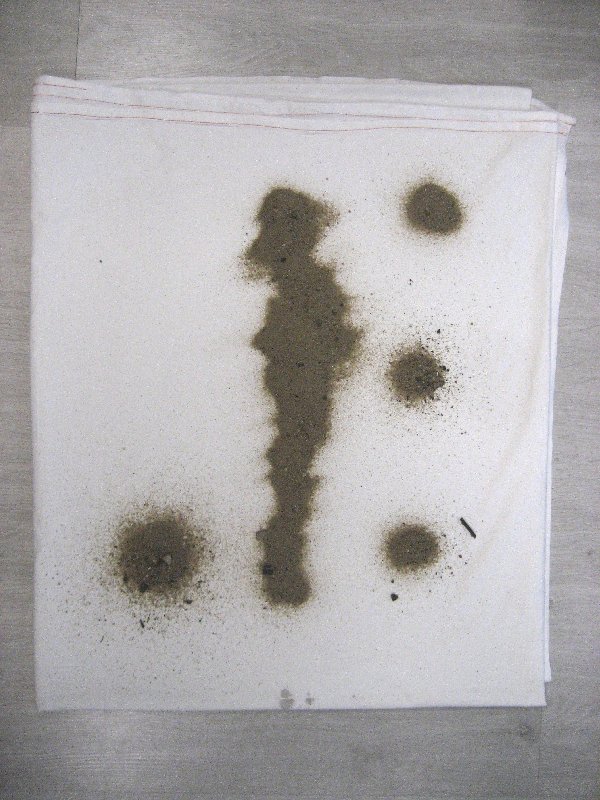
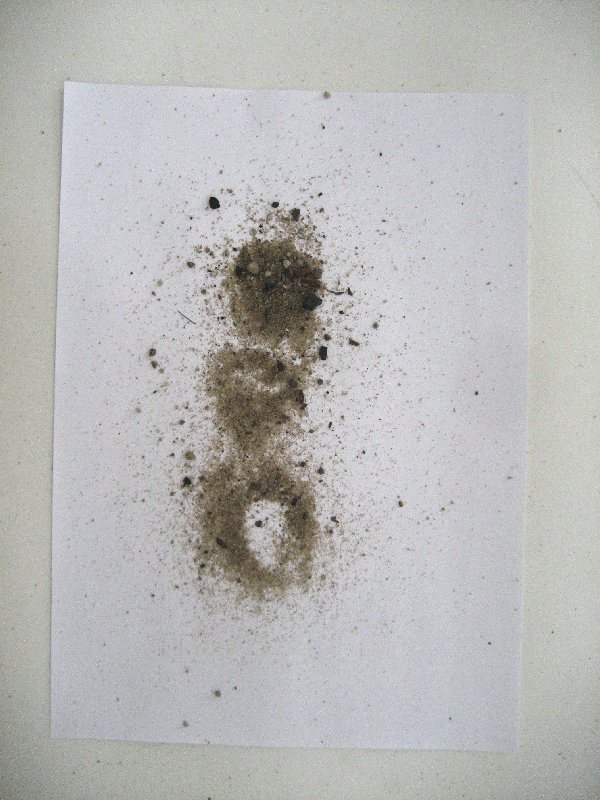
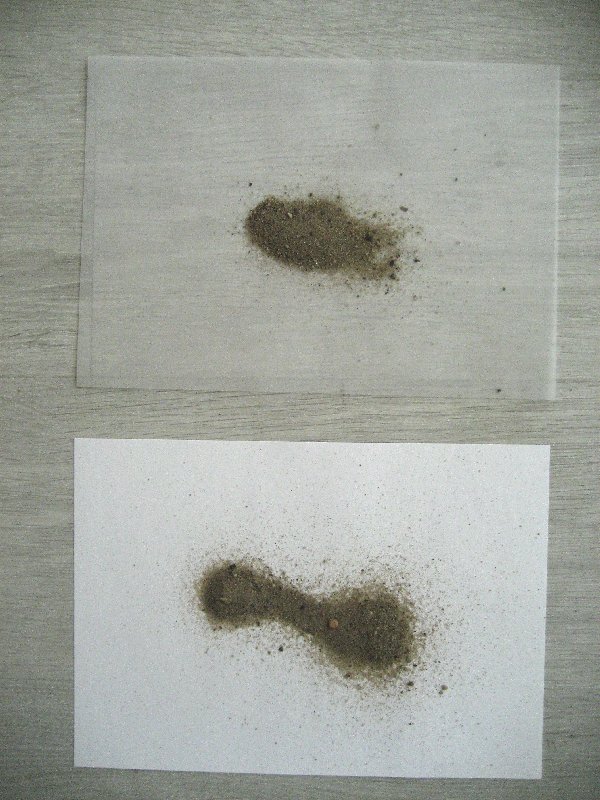
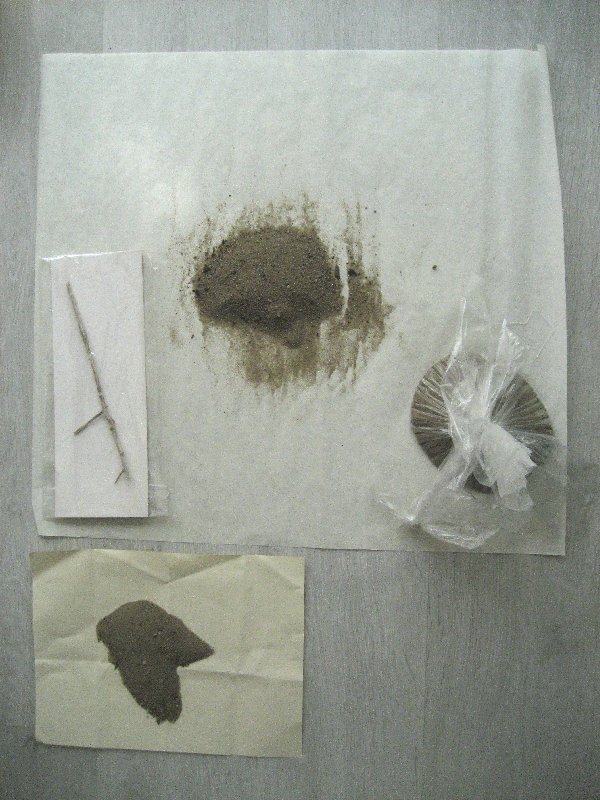
Studies for "Quartz", sand on paper and white linnen, atelier studies 2015
QUARTZ
"How many grains of sand are in one cubic meter? And how much space for seven billion grains of sand? One of them is me." (Peter Ablinger)
Two small, framed travel photos taken by Peter Ablinger are the starting point of his five-part exhibition: both are images of sand dunes; one shows Råbjerg Mile, a shifting dune in Denmark, in 2010 and the other the desert sands of Iran near Mesr in 2011. Both photographs, together with an hourglass, open the exhibition like a programmatic heading that links the sand of different places with the passage of time, the classic "vanitas" motif.
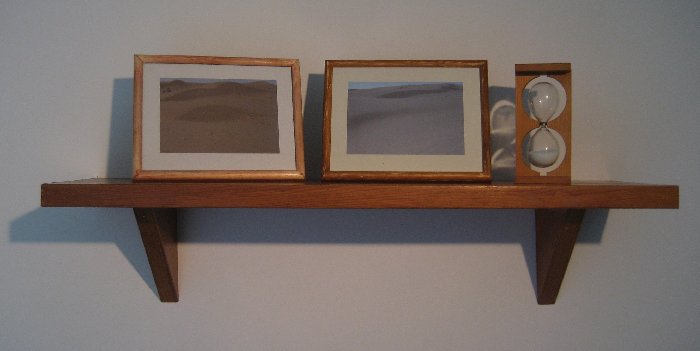
Quartz is the mineral of which sand for the most part consists. In the next room we encounter a quartz clock whose ticking is amplified by a microphone. One property of the mineral quartz is that the duration of its electric oscillations precisely match the duration of our seconds, which is why it is suitable as the timekeeper in the quartz clock. But if we listen very carefully, we hear that not every second sounds the same, and that every minute there are cycles to be discovered which recur, but never exactly the same way. A book by the philosopher Quentin Meillassoux, Après la finitude, serves as the base of the clock, as if listening were supported by thinking.
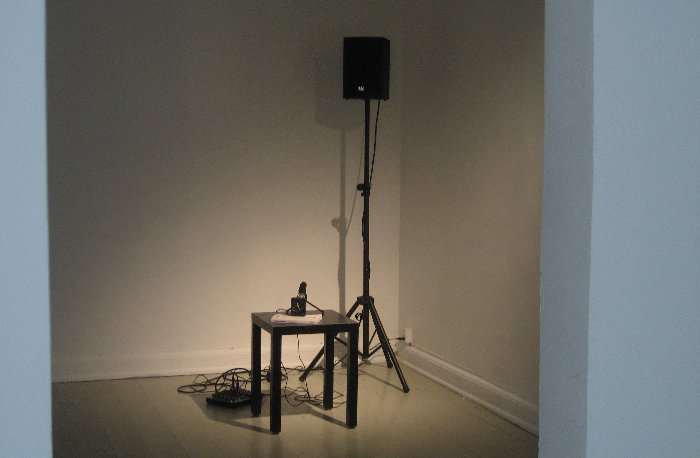
Twelve large sheets of paper spread out on the floor, strewn with (Danish) sand, take up almost the entire third room. This work is part of his Sounds on Paper series and centers on the phenomenon of the musical score and of sound as idea: a score can be read by a trained musician, which means that he or she imagines the music notated there. Sounds on Paper is a kind of score for those who can't read notes: a sand notation with distinct edges can only come about when the sand has been poured from a slight distance above (very soft); an aura around the marking indicates a pour from a middle height (somewhat louder); an irregular empty center only comes about from a relatively high pouring level, where the energy of the dropping sand immediately whisks the impact's center point away again (distinctly audible). In this way, the image (the observing/reading/thinking) appears to be linked to the sound (listening). The work will gain an additional dimension at the vernissage, when Peter Ablinger will work on and complete the piece live.
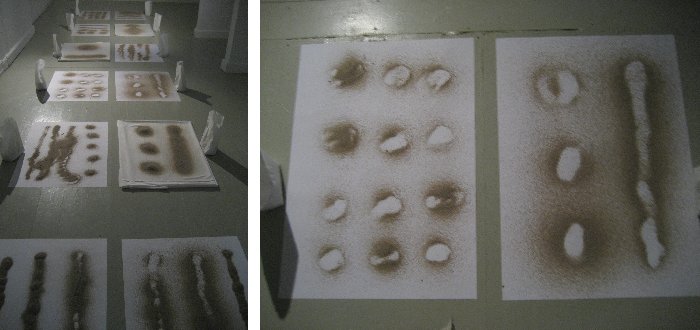
In a niche in the space we find a small monitor and two pairs of headphones. On the monitor we meet the quartz clock we have just seen, flanked by musical notes whose image renews synchronously with the seconds' progress. In the headphones we hear the ticking of the quartz clock together with its spectral analysis, which renders that very same - surprisingly varied - ticking as music.
Quartz Music: start video here and set it into loop mode
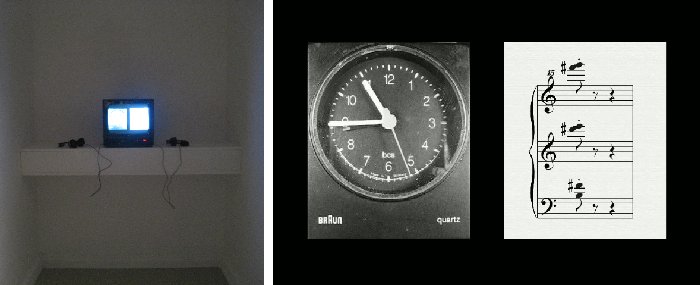
A video screen forms the concluding aspect at the end of the space; we have heard its sound the whole time, but only in coming closer do we identify it as a sandstorm. Peter Ablinger uses a small branch to write two alternating words in Farsi in the Iranian desert sand, his letters immediately erased by the wind: "thinking" and "listening".
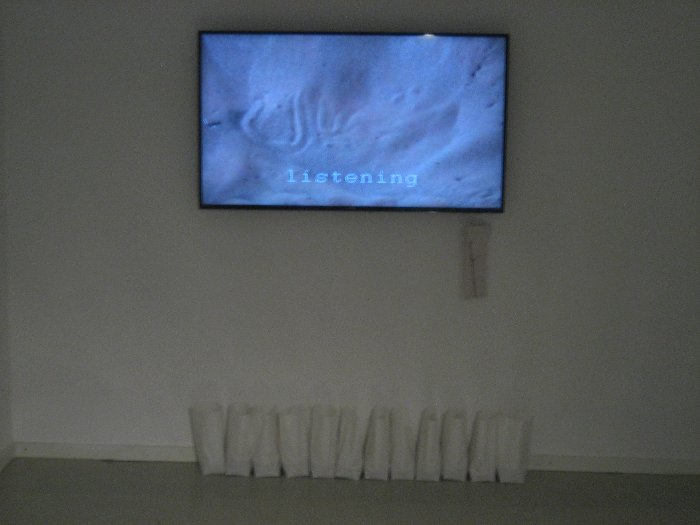
Peter Ablinger decribes the concept "thinking/listening" as: "almost a mantra or prayer. One can do it oneself and become aware of the difference between thinking and listening, the differing ways of being-in-the-world according to whether we - as during 99% of the day - are caught up in our thoughts and not hearing the world around us, or whether we - in listening - not only discover ourselves within it but also, to a certain extent, re-discover ourselves." Another text states: "listening means 'being here'; thinking means 'being elsewhere'."
The volume of seven billion grains of sand, and everything in this exhibition that seems to evoke the qualities or the parameters of sand - drawing, time, trickling (shifting), wind, sound and the idea of sound - become part of a dense web of relationships and a meditation on fleetingness and the uncountable, presence and impossibility.Pictures from the exhibition "Quartz", Kunsthal 44 Mřen, 2015
Text: Ursula Block, Maria Tržan
Translation: Andrea Lerner
Photos: Maria Tržan
Quartz, the installation, how to install
for score and material, as well as for further informations, contact the publisher:
 ZEITVERTRIEB WIEN BERLIN
ZEITVERTRIEB WIEN BERLIN
Bryan Eubanks, Gotzkowskystr. 15, D-10555 Berlin,
T: +49 / 176 / 47 39 29 97, zeitvertrieb@proton.me
Augmented Studies - The Series
see also:
> Quartz, for high orchestra
> Die durchscheinende Zeit
> Renate Fuczik
> TIM Song, a Pop Song
> Die ungarische Brücke